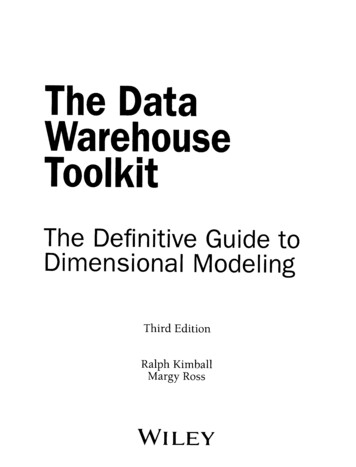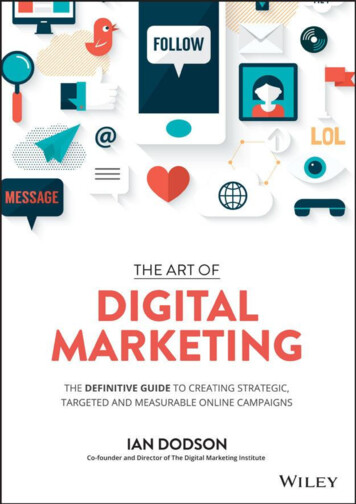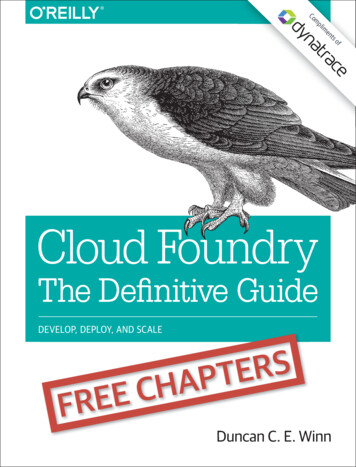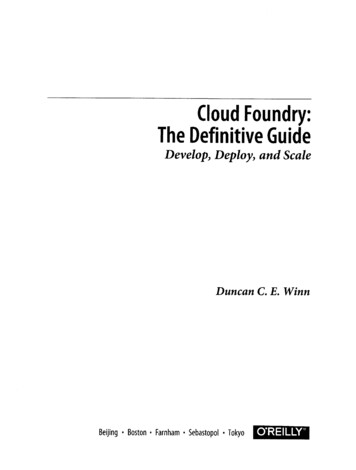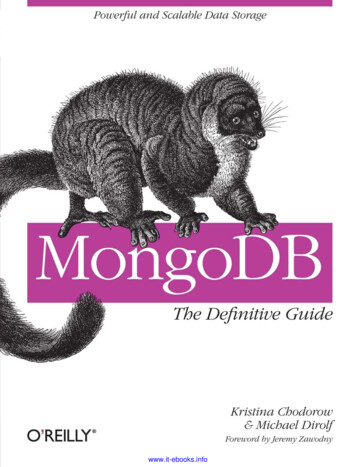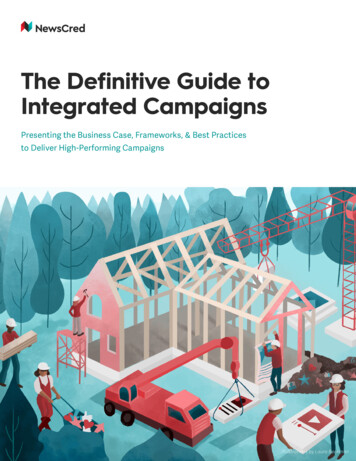
Transcription
The Definitive Guide toIntegrated CampaignsPresenting the Business Case, Frameworks, & Best Practicesto Deliver High-Performing CampaignsIllustrations by Laura Beckman
Contents4Introduction6The business case for integrated campaigns13Best practices: A checklist for integration14Framework: Planning & execution18Template: Integrated campaign planning20How to kick-start integrated campaigns31Best practices: Do’s and don’ts33Key takeawaysThe Definitive Guide to Integrated Campaigns3
The Definitive Guide to Integrated Campaigns4
IntroductionWhat do we mean when we say “integratedcampaigns?” We define them as a series ofcoordinated, omnichannel activities, designedto elevate marketing performance by breakingdown internal silos and delivering a unifiedbrand experience through content.Why do integrated campaigns matter? The truth is, customers don’t careabout our organizational silos. They care about the brand experiencethey’re presented with. They know when a marketing or creativecampaign doesn’t feel right — when the elements don’t fit together orthe content doesn’t feel natural or native to the platform — and thisaffects business results.As marketers, we’ve transitioned to invest heavily in audience-centricor needs-based content to engage with ad-avoiding customers. But westill have a long way to go when it comes to creating the kind of brandexperiences that consumers now demand.That brings us to integrated campaigns — the approach that the mostprogressive marketing organizations are shifting towards in orderto elevate their brands. And since 77% of consumers have chosen,recommended, or paid more for a brand that provides a great experience,we predict that those who make the shift will outperform the rest.PRO TIPIf you’re currently a NewsCred customer, refer to the ProTips throughout the guide to see how best to leverage theCMP throughout the integrated campaign process.The Definitive Guide to Integrated Campaigns5
Why now?67%of customers say their expectationof a “good experience” is higher thanit has ever been.Salesforce77%of consumers have chosen,recommended, or paid morefor a brand that provides agreat experience.ForresterThe Definitive Guide to Integrated Campaigns6
90%Purchase intent improves by 90% whenconsumers view consistent messagingacross multiple channels.IAB2XMarketers who are “integrators” growtheir revenues at twice the average rateof S&P 500 companies: at least 10%annually versus 5%.McKinseyThe Definitive Guide to Integrated Campaigns7
About this guideMarketers need to take a closer look to ensure thattheir campaigns are actually bringing all the relevantchannels and content together in a meaningful way.It’s an integrated marketing approach and though it’s not a new concept — withthe influx of marketing technologies, explosion of channels, and rising expectations— it’s just a matter of how quickly organizations can make the shift. This is why it’scritical to adopt a framework and supporting technology that ensures that everytouchpoint is consistent and executed with streamlined processes.In this guide, we take a deep dive into integrated campaigns: how we define them,why they matter, and how to go about successful planning and execution.We’ll cover three key topics: The business case for integrated campaigns The NewsCred Integrated Planning Framework Best practices for integrated campaignsThis guide is designed for organizations and anyone who is interested in integratedcampaigns, whether you’re just getting started or are looking for ideas to optimizeyour current processes.Ready to transform your marketing?The Definitive Guide to Integrated Campaigns8
3 reasons to invest inintegrated campaignsMost larger organizations have multiple campaign plans across manylines of business, each of which have their own campaign processes.So why go through the trouble of creating a shared campaign model?Well, organization-wide governance with a repeatable model increasesefficiency, drives performance, and reduces duplicative work. It’s amarker of a truly sophisticated marketing organization.1Integrated campaigns perform better.Research shows that consumers viewing a consistent message across avariety of channels can improve purchase intent by 90%. (IAB)2Integrated campaigns preventcontent waste.Enterprises spend between 150M and 250M on content related activitiesper year, but 20% of all content produced is never distributed. (Accenture)3Integrated campaigns aremore likely to deliver a bettercustomer experience.Customer satisfaction is 23x higher in companies who runomnichannel strategies. (Aberdeen Group)The Definitive Guide to Integrated Campaigns9
REASON #1Integrated campaignsperform betterThe value of integrated campaigns is simple. Theyperform exponentially better.Why? The premise on which integrated campaigns are built is cross-functionalcollaboration. By weaving the efforts of your entire marketing team (demandgen., social media, content, email, creative, etc.) and even external teams suchas public relations (yes — press releases can complement your marketingstrategy) and communications, you can reach a larger audience with a moreunified strategy and a higher quality, omnichannel campaign.Here are some stats that prove the power of integrated campaign performance:1. Research shows that consumers viewing a consistent message across avariety of channels can improve purchase intent by 90%. (IAB)2. Companies with extremely strong omnichannel customer engagementsee a 9.5% year-over-year increase in annual revenue, compared to 3.4%for weak omnichannel companies. (Aberdeen Group)3. Marketers who are “integrators” grow their revenues at twice the averagerate of S&P 500 companies: at least 10% annually versus 5%. (McKinsey)CUSTOMER SPOTLIGHTThe content from Panasonic’s first integratedcampaign elicited a 31% engagement rate,outperforming the 24% industry average.The Definitive Guide to Integrated Campaigns10
REASON #2Integrated campaigns preventcontent wasteA fully-integrated campaign should break down organizationalsilos and foster collaboration. Let’s break down what thismeans in the context of integrated campaigns.The uncomfortable truth is that integrated campaigns, by nature, can bedisruptive. They force teams who might never otherwise communicate towork together. This can be a trying process as it involves reshaping the waypeople work, but it’s well worth it when you consider the statistics reported inthe previous section.If you’re championing the integrated campaign effort, you need to makeit your job to bring new teams into the fold. The more integrated yourorganization becomes, the easier it will be to ensure a single-customer view,which is the key to consistent messaging and success across marketing,sales, and the overall business.Consider the following statistics that show the amount of waste thatmarketing teams are currently responsible for due to a lack of collaborationand inefficient processes:1. Enterprises spend between 150M and 250M on content relatedactivities per year, but 20% of all content produced is never distributed.(Accenture)2. In a survey of 1,000 marketers worldwide by Rakuten Marketing,respondents estimated they waste an average of 26% of their budgets onineffective channels and strategies. (Rakuten Marketing)3. 25% of CMOs’ digital media investment reaches target audiences,representing more than 20 billion of marketing waste, inefficiency, andineffectiveness. (ANA)The Definitive Guide to Integrated Campaigns11
REASON #3Integrated campaigns are more likely todeliver a better customer experienceIntegrated campaigns are now the standard — not theexception. It’s what customers expect.A study from Salesforce revealed that customer standards for a goodexperience are higher than they’ve ever been.What does this mean? Marketers need to start shifting to integratedcampaigns and add more rigor to their processes in order to meet thedemands of their audiences: on-brand and innovative campaigns withpersonalized and consistent messaging, delivered to them throughrelevant channels.Here are some statistics that prove the value of integrated campaignsfrom a customer’s point of view:1. Customer satisfaction is 23x higher in companies who runomnichannel strategies. (Aberdeen Group)2. 73% of consumers shop on more than one channel.(Harvard Business Review)3. Integrated and customized campaigns are 57% more effective thannon-integrated campaigns, but less than half of the campaigns areboth integrated and customized. (Kantar Millward Brown)The Definitive Guide to Integrated Campaigns12
TACTICSA best practiceschecklist for integrationBefore you start executing, askyourself if your campaign is:UnifyingCampaigns should contain a unifying idea formaximum impact.ConsistentCampaigns should have consistent messaging anddesign for a better brand experience.CustomCampaigns should be custom fit by tailoring toformat, channel, and audience.MeasurableCampaigns should align to goals determined duringthe planning stage so you can measure their impactand return on investment.StreamlinedCampaigns and their processes should be supportedand enabled by technology.CollaborativeCampaigns should break down organizational silosto reach the ideal state of integration.The Definitive Guide to Integrated Campaigns13
A NewsCred FrameworkHow to plan and executeintegrated campaignsMarketing organizations are rarely created equally.Team size, budget, organizational growth stage, geographic footprint — allof these factors play a role in how marketing teams develop their campaignsto support their current business objectives. Often, we see three levels ofcampaigns throughout a marketing org’s transition to full integration.The Definitive Guide to Integrated Campaigns14
LEVEL 1Need-based campaignsNeed-based campaigns are aligned to buyers’ needs and typically followa one-off approach. Each campaign strategy is developed individually totarget a specific persona and achieve a specific outcome. This can takethe form of a short, time-bound efforts to connect with potential buyers,or ongoing persona-based nurturing tactics such as email comeCampaignPersonaOutcomeThe Definitive Guide to Integrated Campaigns15
A NewsCred FrameworkLEVEL 2Coordinated campaign planningAs campaign orchestration matures, marketing orgs graduate tocoordinated planning, supported by the creation of sub-campaigns. Inthis scenario, a high-level, strategic campaign has a broad theme — stillaligned to a buyer need or business objective — but tells the biggerpicture campaign story. The strategic campaign might be centeredaround thought leadership initiatives, brand-oriented activities, userconferences, and other awareness-building activities. There are thenseveral, more targeted sub-campaigns that ladder up to the overarchingcampaign theme. For example, your strategic campaign might beyour go-to-market, in which case each supporting campaign would beconsidered a sub-campaign.From an execution standpoint, efforts are coordinated, but teamsaren’t operating cross-functionally or at scale. Meaning, they’re notcollaborating on, sharing, or repurposing campaign assets and gnThe Definitive Guide to Integrated Campaigns16
LEVEL 3Integrated marketing andintegrated campaignsWhen it comes to campaigns, this is the holy grail of integration. It involves thecollaboration of various teams, markets, and lines of business across the organizationto execute a series of coordinated, omnichannel marketing activities that ladder up toa broader initiative. Campaign efforts, content, and teams span each sub-campaign,allowing for integrated marketing at scale — which ideally means transforming siloed,one-off initiatives into an omni-channel experience supported by rategicCampaignSub-campaignSub-campaignThe Definitive Guide to Integrated Campaigns17
A NewsCred FrameworkIntegrated CampaignPlanning TemplateGoalsCross-functionalinput.Regardless of which level of integration yourorganization is currently operating in, our NewsCredTeamsCampaign Framework can help to support the planning,execution, and measurement of campaigns.Documentcampaign goals.The NewsCred Campaign Framework combines 6key elements (Goals, Audience, Message, Channels,Workflows, and Measurement) with 6 key inputs (Teams,Activities, Deliverables, Budgets, Timeline, and CMP).ActivitiesThe last input, of course, is dependent on access toNewsCred’s CMP.We recognize that all organizations operate differently,so this framework should serve as an initial blueprint towhich you should make adjustments that will best suitDeliverablesDocumentedcampaign goals.your organization’s needs.BudgetTimelineCMPThe Definitive Guide to Integrated CampaignsIdentify budgetsources and limits.Set key deadlinesfor the goals.Upload goals andobjectives to the“Campaign Brief” tabof your campaign inNewsCred’s CMP.18
AudienceMessageChannelsWorkflowsMeasurementLed by MarketingTeam. May includeinput from Product,Sales, and CustomerSuccess Teams, ifapplicable.Messagedevelopment is led bythe Marketing Teamwith input from Salesand Product Teams.Global teams createan umbrella campaignand local teams adaptto target local markets.Determinekey campaignstakeholders,approvers, andteams.Marketing Team towork with DemandGen role to reporton how campaignsare performing andleading to salesenablement.Identify the targetaudience, theirneeds, and theirpain points.Describe the keymessage of thecampaign, and howit will help promoteyour product, service,or brand. Add it toyour campaign brief.Determine whichchannels will bestreach your targetaudience, how you’lluse them, and thebudget allocatedfor each.Map workflow foreach channel andtask. (Consider:What does theapproval processlook like?)Report on campaignperformance.Campaign- specificaudience segments.Established campaignmessaging includedin a campaign brief.A documented channelplan (which channelswill be used and forwhat purpose).Establishedcampaign taskworkflowsA report on campaignresults according tothe predeterminedgoals/KPIs.If applicable,establish budgetbased on audiencesegment.N/ADevelop channelspecific budgets.N/AMonitor budgetSet key deadlinesfor establishing thetarget audience.Set key deadlinesfor determining themessage.Set key deadlinesfor the deliverablesassociated with eachchannel.Set key deadlinesfor establishingthe workflows.Set key deadlinesfor campaignmeasurement andoptimization.Update campaigntaxonomy to ensurecampaign personasare reflected.Add messagingguidelines to the CMPin the “CampaignBrief” tab.Ensure each channelis connected forpublishing (e.g.LinkedIn, Twitter,Marketo, etc.)Consider whetheryou need flexibleor rigid workflowsfor each campaigntask, and buildthem in the CMP.Gather data andinsights fromcampaign analyticstab and makerecommendations foriterations and futurecampaigns.This framework has been adapted from the SiriusDecisions Campaign Framework as originallypublished in "The SiriusDecisions Implementation Process Core Strategy Report."The Definitive Guide to Integrated Campaigns19
How to kick-startintegrated campaignsSTEP 1Assemble your Tiger TeamAfter securing executive support, your first step shouldbe to establish a core working team of leaders across themarketing organization, ideally from different departments.What is a Tiger Team?Integrated campaigns work best when diverse functions(brand, marketing, comms, PR, social, etc.) are alignedon a single customer journey. In companies where thesefunctions sit in silos, the best way to drive integration isvia a Tiger Team.A Tiger Team is a cross-functional team comprised ofmembers that represent various areas of expertisewithin an organization. This centralized team is typicallymade up of leaders and/or executives, as they needthe credibility and influence to lead organizationalchange. They should be committed to encouragingcollaboration, evangelizing an omnichannel approach,and implementing integrated campaigns.PRO TIPAs you onboard new teams to the integrated efforts, itmay be a good idea to re-evaluate who makes up theTiger Team to best meet the goals of that deployment.The Definitive Guide to Integrated Campaigns20
STEP 2Hold a Tiger TeamActivation WorkshopOnce you’ve determined who will be on your Tiger Team, set upa stakeholder session to activate the process. Here’s a sampleworkshop agenda:1OverviewDiscuss the vision, overarching goals, and the criticalrole of integrated campaigns.2Context & goal settingOutline current challenges and how an integratedapproach to campaigns can help solve for them. Introducestakeholders to integrated best practices, align onscope of work, and determine goals across stakeholders.3GovernanceLook at roles, responsibilities, and how the team willgovern and evaluate campaign success.4Campaign planning frameworkDecide on a planning framework. Communicate bestpractices and benefits related to integrated planningand campaigns (for a template, see the NewsCredCampaign Planning Framework on pages 18-19).5Campaign workflow mappingMap out the integrated campaign workflows (considerapproval processes for campaign-related deliverables).6Taxonomy best practicesDiscuss applications for taxonomy, including strategicalignment, analytics and reporting, and contentutilization. Build out a labeling structure that makes themost sense for your organization.The Definitive Guide to Integrated Campaigns21
TACTICSHow to get buy-inColleagues not convinced? The best way to getbuy-in is to know their value drivers and pain points.Content TeamCorporate Communications TeamYour Content Team can (and should) be your biggestThe Communications Team (and PR Team) care aboutallies. They understand the value of content as areputation and protecting their brand’s identity,connector of the organization, but are all too familiarespecially in highly-regulated industries. Their job is towith duplicated and wasted efforts. They know thatpresent the organization favorably in the eyes of theproactive planning and scaling is better than reactive,public, media, investors, and employees. Integratedad hoc content creation. They should welcome thecampaigns will solidify the consistent use of approvedidea of an integrated approach because they knowmessaging and brand elements that all play into thethat their content connects the customer experienceCorporate Comms agenda.across all channels, and by approaching contentcreation in this way, they’ll be able to do their jobsBrand Teamboth more effectively and more efficiently.Integrated campaigns help to elevate brands throughunified storytelling on a large scale. Your sellingSocial Teampoint here is that through increased collaboration,Members of the Social Team are great candidatesyour marketing org will be able to execute integratedfor bolstering your integrated marketing efforts. Forcampaigns, which should increase your share ofthe social team, an integrated approach means thatvoice in the market. Governance is also an importantall social channels are utilized in a consistent andbenefit to bring up for the brand team: followingholistic narrative. This will help them better collaboratebrand guidelines when it comes to everythingand be central to content distribution. They shouldfrom messaging and values to colors and fonts arebe consulted from the start of campaign planning,important aspects for maintaining a strong brand.which will generate efficiencies in asset and contentproduction and lead to greater consistency across theMarketing Operations Teamchannels they manage.This team will most likely be one of the key stakeholdergroups for integrated marketing and should produceDemand Generation Teampotential champions. Their focus is on software,One of the advantages of an inte
It’s an integrated marketing approach and though it’s not a new concept — with the influx of marketing technologies, explosion of channels, and rising expectations — it’s just a matter of how quickly organizations can make the shift. This is why it’s critical to adopt a framework





